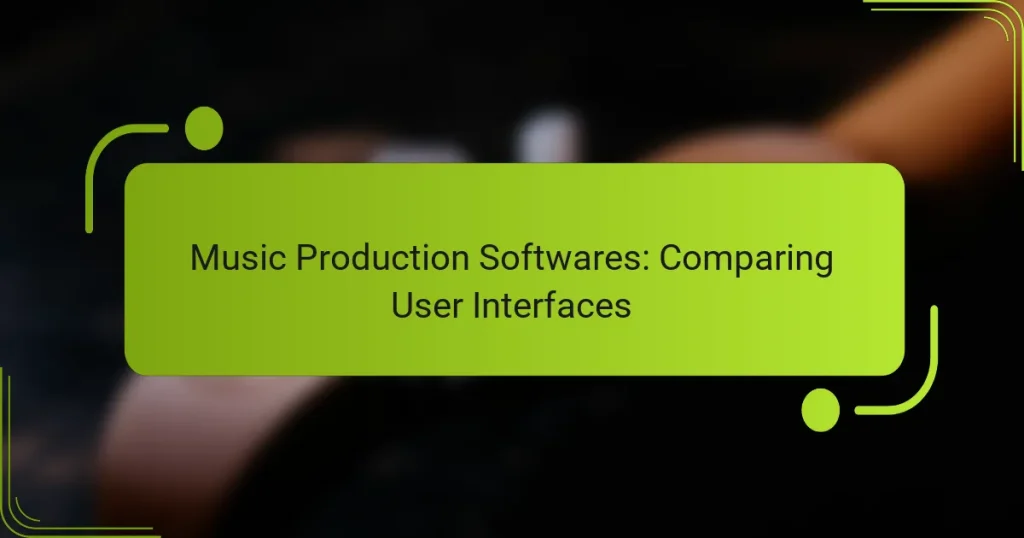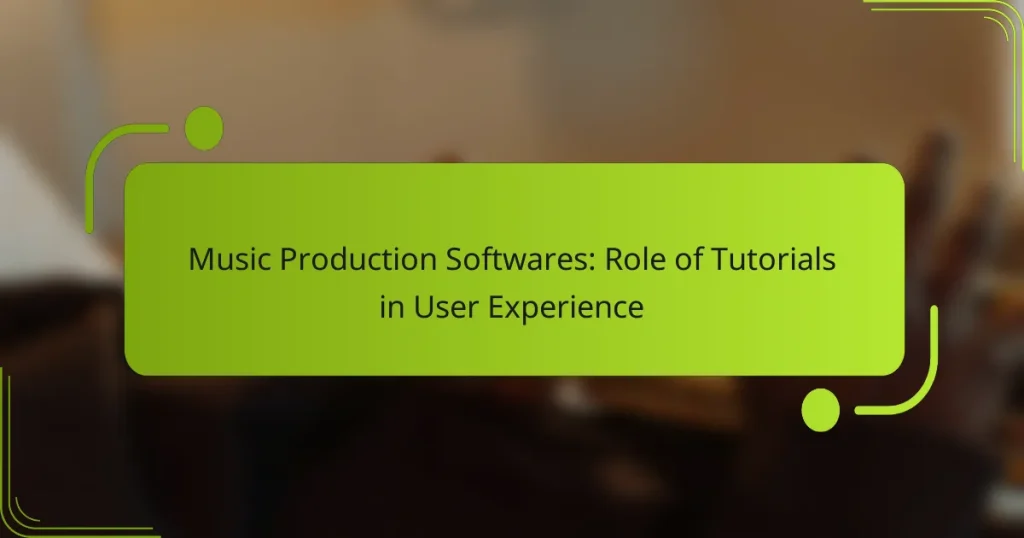Music production software with user-friendly interfaces, such as Ableton Live, FL Studio, and Logic Pro X, simplifies the creative process for both novices and seasoned producers. These platforms are designed to minimize distractions and enhance efficiency, allowing users to focus on their music rather than grappling with complicated tools. With intuitive layouts and customizable controls, they provide an accessible entry point into the world of music creation.
Music Production Softwares: Comparing User Interfaces
Music Production Softwares: Role of Tutorials in User Experience
Which music production software has the most user-friendly interface?
Ableton Live, FL Studio, and Logic Pro X are among the top contenders for the most user-friendly music production software. Each offers intuitive layouts and features that cater to both beginners and experienced producers, making the music creation process more accessible.
Ableton Live
Ableton Live is renowned for its straightforward interface, which allows users to easily navigate through its various features. The Session View provides a unique way to experiment with musical ideas in a non-linear format, making it ideal for live performances and quick arrangements.
Key features include drag-and-drop functionality and a clear layout of instruments and effects. Beginners often appreciate the built-in tutorials that guide them through the essential tools and workflows, enhancing their learning experience.
FL Studio
FL Studio is celebrated for its visually appealing and user-friendly interface, especially for electronic music producers. The pattern-based workflow allows users to create beats and melodies quickly, making it easy to experiment with different sounds.
The software includes a variety of pre-installed plugins and samples, which can simplify the production process for newcomers. Additionally, the piano roll feature is intuitive, enabling users to edit notes and rhythms with ease.
Logic Pro X
Logic Pro X offers a clean and organized interface that appeals to Mac users. Its comprehensive toolset is well-integrated, allowing for seamless transitions between recording, editing, and mixing. The software is particularly favored for its powerful MIDI capabilities and extensive library of sounds.
While it may have a steeper learning curve than some alternatives, the user-friendly design and helpful resources, such as video tutorials, make it manageable for beginners. The Smart Controls feature simplifies the process of adjusting multiple parameters at once, streamlining the workflow.
How do user-friendly interfaces enhance music production?
User-friendly interfaces significantly enhance music production by streamlining the creative process and minimizing distractions. These interfaces allow producers to focus on their music rather than struggling with complex software, leading to more efficient and enjoyable sessions.
Improved workflow efficiency
User-friendly interfaces contribute to improved workflow efficiency by simplifying navigation and reducing the time spent on technical tasks. When software is intuitive, producers can quickly access tools and features, allowing them to spend more time creating and less time troubleshooting.
For example, drag-and-drop functionality and customizable layouts can help users organize their projects more effectively. This can lead to faster project completion and a more satisfying creative experience.
Reduced learning curve
A user-friendly interface significantly reduces the learning curve for new users, making it easier for them to start producing music. Intuitive designs often include tutorials, tooltips, and user-friendly documentation that help beginners grasp essential concepts quickly.
For instance, software that uses visual cues and clear icons can help users understand functions without extensive training. This accessibility encourages more people to explore music production, fostering a diverse range of creativity in the industry.
What features define a user-friendly music production software?
User-friendly music production software typically includes an intuitive interface, customizable controls, and accessible tutorials. These features enhance the user experience, making it easier for both beginners and experienced producers to create music efficiently.
Intuitive layout
An intuitive layout is crucial for music production software, as it allows users to navigate the program with ease. Key elements like a clear arrangement of tools, logical grouping of features, and a visually appealing design contribute to a seamless workflow. For example, software that uses drag-and-drop functionality can significantly reduce the time spent on arranging tracks.
When evaluating software, look for customizable workspace options that let you arrange panels and tools according to your preferences. This flexibility can enhance productivity by allowing you to focus on the features you use most often.
Customizable controls
Customizable controls enable users to tailor their experience according to their specific needs and workflow. This can include adjustable shortcuts, assignable MIDI controls, and the ability to create personalized templates. By having control over how the software responds to your inputs, you can streamline your music production process.
Consider software that allows you to save and recall different configurations, which can be especially useful when switching between projects or genres. This adaptability can help you maintain focus and efficiency during the creative process.
Accessible tutorials
Accessible tutorials are essential for users to quickly learn how to utilize the software effectively. Look for platforms that offer a variety of learning resources, such as video tutorials, written guides, and interactive help features. These resources can significantly reduce the learning curve for new users.
Additionally, community forums and support channels can provide valuable insights and tips from other users. Engaging with these resources can enhance your understanding and help you troubleshoot common issues as you explore the software’s capabilities.
What are the top user-friendly music production software options in the US?
The top user-friendly music production software options in the US include GarageBand, PreSonus Studio One, and Reason Studios. These platforms are designed to simplify the music creation process, making them ideal for beginners and those looking for intuitive interfaces.
GarageBand
GarageBand is a free digital audio workstation available exclusively for macOS and iOS users. It offers a straightforward interface, making it easy for beginners to start producing music without overwhelming features.
Key features include a variety of virtual instruments, pre-recorded loops, and built-in effects. Users can easily drag and drop elements to create their tracks, which is particularly useful for those new to music production.
PreSonus Studio One
PreSonus Studio One is known for its single-window workspace that integrates all essential tools in one place. This design minimizes distractions and allows users to focus on their music creation.
The software includes a drag-and-drop functionality, making it easy to arrange and edit tracks. It also offers a range of professional-grade features, such as advanced automation and a robust mixing console, suitable for both beginners and more experienced users.
Reason Studios
Reason Studios combines a user-friendly interface with a modular approach to music production. Users can create their own virtual rack of instruments and effects, allowing for a highly customizable experience.
This software is particularly appealing for those interested in sound design, as it provides a wide array of synthesizers and samplers. The intuitive layout helps users navigate through complex processes without feeling lost.
What criteria should be considered when choosing music production software?
When selecting music production software, consider factors such as budget, hardware compatibility, and the specific needs of your target audience. These criteria will help ensure that the software meets your creative and technical requirements effectively.
Budget constraints
Budget is a crucial factor when choosing music production software, as prices can vary widely. Many options range from free software to premium versions that can cost several hundred dollars. Determine your budget early on to narrow your choices and avoid overspending.
Look for software that offers a good balance between features and price. Some affordable options provide essential tools for beginners, while others may offer advanced features for a higher cost. Consider free trials to evaluate functionality before committing financially.
Compatibility with hardware
Ensure that the music production software is compatible with your existing hardware, such as audio interfaces, MIDI controllers, and computers. Check the software’s system requirements to avoid performance issues or crashes.
Some software may work better with specific operating systems, like Windows or macOS. If you use specialized hardware, confirm that the software supports it to maximize your workflow and efficiency.
Target audience needs
Understanding the needs of your target audience is essential for selecting the right music production software. Different users, such as hobbyists, professionals, or educators, may require distinct features and functionalities.
For instance, beginners might prefer user-friendly interfaces with basic tools, while experienced producers may seek advanced capabilities like multi-track recording and extensive plugin support. Tailor your choice to the skill level and specific requirements of your audience to enhance their experience.
How do user-friendly interfaces compare across different music production software?
User-friendly interfaces in music production software are crucial for enhancing workflow and creativity. They vary significantly across platforms, impacting how easily users can navigate features and tools.
Feature comparisons
When comparing user-friendly interfaces, consider the layout, accessibility of tools, and customization options. Software like Ableton Live is known for its intuitive session view, which allows for easy arrangement and experimentation, while FL Studio offers a visually appealing interface with a straightforward workflow for beginners.
Another aspect to consider is the learning curve associated with each software. Programs like GarageBand provide a simplified experience ideal for novices, while more complex options like Logic Pro X might require a deeper understanding of music production concepts. Users should assess their skill level and choose software that aligns with their comfort and experience.
Navigation: Look for software that allows quick access to essential tools.
Customization: Choose platforms that let you personalize your workspace.
Support: Consider the availability of tutorials and community resources for assistance.


